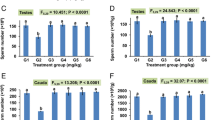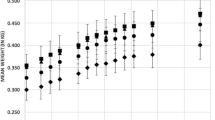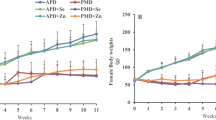Abstract
Nickel sulfate (2.0 mg/100 g.b.wt) dissolved in double-distilled water was administered (ip) on alternate days for ten doses to normal protein-fed and protein-restricted Wister strain albino rats (b.wt. 160 ± 5 g). Two groups were used: one with normal protein diet, whereas the other with protein-restricted diet served as control. Twenty-four hours after the last treatment, the animals were sacrificed by decapitation. Tissues such as the testes, seminal vesicles, epididymis (Cauda and Caput) and prostate were dissected out, wiped clean, and stored at -20‡C until analysis. Lactate dehydrogenase (LDH) activities, glutamate oxaloacetate transaminase (GOT) activities, glycogen content, cholesterol content, and total protein content of the testes were estimated. Nickel sulfate administration significantly decreased the body weight of both normal protein-fed and proteinrestricted groups of animals; the organ weights were also decreased. Significant decrease of LDH activity was observed, but GOT activity was not altered significantly. Testicular glycogen and cholesterol increased significantly in both experimental groups, but total protein content decreased. Nickel sulfate seems to have an adverse effect on the male reproductive system in both groups of animals fed with normal protein (18% casein) diet and protein restricted (5% casein) diet.
Similar content being viewed by others
References
F. H. Nielsen,Advances in Modem Toxicology, vol. 2, 3rd ed., Hemisphere, Washington, DC, pp. 129–146 (1977).
E. J. Underwood,Trace Elements in Human and Animal Nutrition, Academic, New York, p. 7 (1977).
J. Xie, T. Funakoshi, H. Simada, and S. Kojima, Effects of chelating agents on tissue distribution and exeretion of nickel in mice,Res. Commun. Mol. Pathol. Pharmacol. 86, 245–255 (1994).
H. A. Schroeder and M. Mitchener, Toxic effects of trace elements on the production of mice and rats,Arch. Environ. Health 23, 102–106 (1971).
S. Dasgupta, S. K. Biswas, and K. K. Das, Effect of nickel on acid and alkaline phosphatase activities in the reproductive system of male rats during protein restriction,Med. Sci. Res 17, 95–96 (1989).
E. Bordes and V. V. Papillian, Myocardial change induced by nickel and in association with cadmium,Rev. Ig. Bacterial, Virusal., Parazitol., Epidemiol, Pneumotiziol. 32, 51–56 (1983).
J. King,Practical Clinical Enzymology, 2nd ed., Van. D. Nostrand, London, p. 83, 285 (1965).
H. Bergmeyer,Methods in Enzymatic Analysis, 2nd ed., Academic, New York (1984).
R. Montgomery, Estimation of liver glycogen,Arc. Biochem. Biophys. 67, 378 (1957).
O. H. Lowry, N. J. Rosebrough, A. L. Farr, and R. S. Randall, Estimation of protein by using Folin-Phenol reagent,J. Biol. Chem. 193, 267–275 (1951).
N. Chiamori and R. J. Henry, Study of the chloride method for determination of total cholesterol and cholesterol esters,Am. J. Clin. Path. 31, 305–309 (1956).
A. Ray, S. Chatterjee, P. Bagchi, and C. Deb, Effect of quinolphos on testicular steroidogenesis in rats,Andrologiya 20, 163–168 (1988).
J. R. Davis and C. F. Firlit, Effect of glucose on uptake of L-Lysine-H3 in cells of the seminiferous epithelium,Am. J. Physiol. 209, 425 (1965).
M. J. Free and N. L. VanDemark, Gas tensions in spermatic and peripheral blood of rams with normal and heat treated testes,Am. J. Physiol. 214, 863 (1968).
T. Mann,The Biochemistry of Semen and the Male Reproductive Tract, 1st ed., Metheun, London (1964).
A. D. Johnson, W. R. Gomes, and N. L. VanDemark,The Testis vol. 2; 1st ed. 183, Academic, New York (1970).
S. Chatterjee, A. Ray, P. Bagchi, and C. Deb, Suppression of testicular steroidogenesis in rats by the organochlorine insecticide aldrin,Environ. Pollut. 51, 87–94 (1988).
M. Gupta, S. N. Dey, and S. Duttagupta, Lipid spectrum in different tissues of MT 81 toxin treated mice,Toxicology 37, 247–257 (1985).
Author information
Authors and Affiliations
Rights and permissions
About this article
Cite this article
Das, K.K., Dasgupta, S. Alteration of testicular biochemistry during protein restriction in nickel treated rats. Biol Trace Elem Res 60, 243–249 (1997). https://doi.org/10.1007/BF02784444
Issue Date:
DOI: https://doi.org/10.1007/BF02784444




